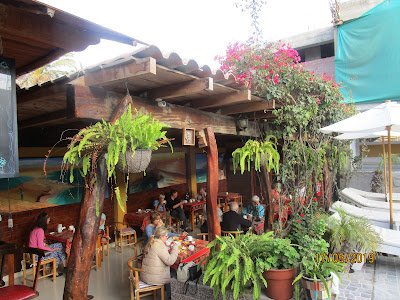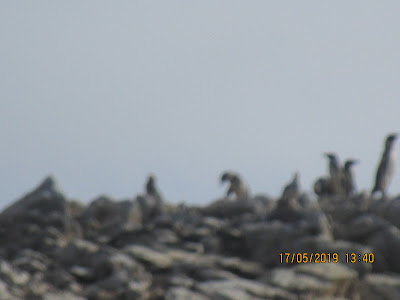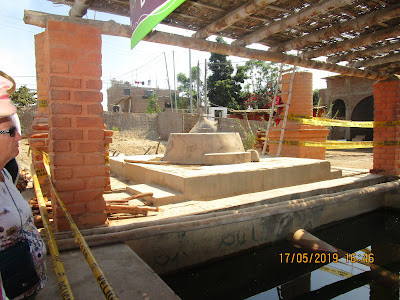The Ballestas Islands are a group of rocky islands located off Paracas. They are nicknamed "The Poor Man's Galapagos" and are home to thousands of birds and mammals, including penguins, sea lions, terns, pelicans and dolphins.The islands are protected which means you cannot swim with the animals or walk on the islands. But you can get very close by boat. I'm sure Phil's photos must be great - he is a professional photographer.
This is the Paracas Candelabra known locally as the "Candelabra of the Andes. It is a massive geoglyph which looks like a massive branched candlestick which stretches 600 feet from top to bottom. Its origin is unknown. It is estimated to date back to 200 BC or even farther back. It was created by digging 2 feet deep into the hardened soil with rocks placed around the figure. A number of theories exist as to its significance. One theory is that it evokes the trident of Incan creator God Viracocha, possibly created to please the god. Another theory suggests that it stands for the local Jimson weed which has hallucinogenic effects and may have had a ritual significance, the large design acting as a beacon home for people tripping on the weed. Alternatively it could have been simply a sign for sailors looking for the Paracas coast.
Guano, the bird poop that covers these islands is rich in nitrogen, phosphate and potassium. This guano is harvested and shipped all over the world. It is obviously the source of the smell that Charlotte found particularly offensive. When I mentioned to Carol that we had been to the Ballestas Islands she remembered that they stank.
The guano is very evident here.
A very poor picture of the Humboldt penguins which were scurrying around and were quite funny.
We got back to the hotel, collected our luggage and set off to the winery at about 10.37 am. We already felt we had had a full day! At the Huacachina winery we were brought through the various stages leading to the production of Pisco. We then sampled about 7 different varieties. I liked the lemon and the creamy ones but they were all very sweet. Our guide was very nice and good fun. She had us all reciting various rhymes while we did our tasting.
Jim did well out of the tasting. Not only did he have his own but he had most of mine too as I took only a sip of each one.
Next stop was the Huacachina Oasis where it was possible to go dune buggying and sandboarding. Sarah was keen but no one else was doing it so she didn't bother. It was very hot - about 28 degrees C. We ordered some food at a cafe and then went for a walk around the oasis. The sand was too much for me so I turned back. Lunch wasn't great but it filled a gap.
Huacachina is a desert oasis and tiny village just west of the city of Ica. At its centre is a lagoon ringed by palm trees. It is Peru's only natural oasis. Its dunes are huge - the largest in Peru. According to legend a hunter saw a beautiful Incan princess walking in the sand dunes near Huacachina. She was admiring herself in a mirror she was carrying. Then she caught his voyeuristic gaze and, in shock, began to flee and dropped her mirror. The mirror exploded into shards and the glass became a tiny pool in the desert, consuming the princess and turning her into a mermaid.
Cerro Blanco sand dune measures 3,860 feet from base to summit and towers over the quaint desert oasis town of Huacachina.
Next we drove towards Nazca and stopped to view one of the Palpa lines. Palpa lines are geoglyphs, not as famous as the Nazca lines but older and most likely created by the Paracas culture, an Andean culture that existed between 800 BC and 100 BC. The purpose of the Palpa lines and geoglyphs is unknown and, like the Nazca lines, are regarded as one of archaeology's greatest enigmas because of their quantity, nature, size and continuity. Scientists suggest that they had ritual astronomical functions. To see them properly required climbing up a platform - lots of steps - so I admired from below.
This one is called "La Familia Real"
Following that we stopped at another platform to see one of the Nazca lines.
Tomorrow there is the possibility to take a flight over the Nazca lines. Jim and I have decided not to go.
Shortly afterwards we reached Nazca and our overnight accommodation, Casa Andina Standard, which was quite a nice hotel. Then we did a "little walking" and then had dinner which was very good. It was Paul's birthday so Henry had got a cake and we all sang Happy Birthday, waiting staff and all.












































































































No comments:
Post a Comment